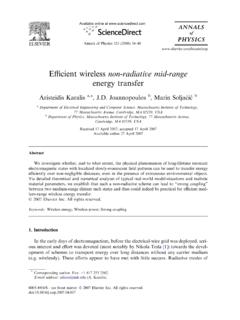Transcription of The Solutions of Wave Equation in Cylindrical Coordinates
1 EMT 93 The Solutions of Wave Equation in Cylindrical CoordinatesThe Helmholtz Equation in Cylindrical Coordinates isBy separation of variables, assume . We only possible solution of the above iswhere , and are constants of , and . and final solution for a give set of , and can be expressed as,where is the Bessel function of the exact values of , , and the forms of the harmonicfunctions and the Bessel function are determined by the general, EMT 94 , if , if integer , if the space contain all range of , that is,.Likewise, the corresponding Solutions for and are 95 EMT 96 The Circular C.
2 Where is the roots of . frequency: impedance: C. where is the roots frequency: impedance: EMT degenerate(). mode: EMT 98 Higher Order Modes of Coaxial Lines mode B. C.: mode B. C.:Dominant: .EMT 99 Homework #7 Problem Circular wave:Radial WaveguideRadial wave: Parallel-plate radial waveguideB. C.: at and TM to z mode: TE to z mode: Phase constant: EMT 100 Note: Wave impedance:Note: real , are complex function of . , is imaginary, is also imaginary, notpropagation, modes: . a.: predominantly resistiveb.: predominantly mode: . Only and exist. TEM,transmission-line wave: EMT 101 Outward wave: Wedge Radial WaveguidesAssume no variation in C.
3 : at and TM to z mode: TE to z mode: Dominant mode: , only and , TEM, : , Outward: EMT 102 The Circular CavityTM to z mode ():TE to z mode ():Dominant mode:1.: . Shorted radial waveguide mode .EMT 1032.: . Shorted circular waveguide mode . , the second resonance is times the firstresonant frequency. For rectangular cavity of small height, of mode:For the same height-to-diameter ratio, the circular cavity has an Q than the rectangular cavity. This is to be expected, since thevolume-to-area ratio is higher for a circular cylinder than for a 104 Other Guided WavesTwo dielectric Circular WaveguidesAssume z-directed propagation waves .
4 Hybrid modes dielectric 1:EMT 105In dielectric 2:B. Cs.: continues at .A linear Equation of unknowns A, B, C, and D. For not trivialsolution, the determinant must be zero, thus solving and .Partially filled circular waveguidesMust satisfy: finite at , at , at .Dielectric-rod waveguides (optical fibers)Must satisfy: finite at , decay for .EMT 106where .Dominant mode: the lowest mode. Zero cut-off conductor waveguidesMust satisfy: at , at , decay for .where .Dominant mode: the lowest TM mode. Zero cut-off 118 Chap 6. Spherical Wave FunctionsSpherical Wave Functions satisfying Helmholtz Equation ().
5 : spherical Bessel order: polynomials of times or . is finite at . out-going waves and , use .Alternatively, for , and can be chosen astwo independently Solutions . All Solutions have singularity at except with integer. Also, for .EMT 119 For TM or TE to z analysis, we haveAlternatively, consider TM or TE to analysis. Note: does not satisfy Helmholtz ,whereThe electric and magnetic fields can be computed byEMT 120 The Spherical CavityFor TE to r, : at . We havewhere are the p-th zero of .Similarly, for TM to r, ,where are the p-th zero of .Resonant frequencies:Note: .EMT 121 The first mode: Degeneracies:example: Orthogonality RelationshipsFrom Green s IdentityEMT 122 Let,then,For Legendre Polynomial Expansion(Fourier-Legendre Series)Let (assume )then,Define tesseral harmonics as,then the spherical wave function and can be written haveEMT 123 SinceWhen ,A two-dimensional Fourier-Legendre series can be obtained for afunction on a spherical surface asThen,EMT 124 Space as a WaveguideTM to r:Then,TE to r:Then,Note:EMT 125 Other Radial WaveguidesConical WaveguideB.
6 C.: Solution space: TM to r:To satisfy the B. C., TE to r:To satisfy the B. C., EMT 126 Biconical WaveguideB. C.: Solution space: Since is not included, use for .TM to r:To satisfy the B. C., TE to r:To satisfy the B. C., EMT 127 Dominant (transmission line) Mode: TEM ()Note: gives zero fields and is not , Wedge WaveguidesB. C.: Solution space: TM ro r: TE ro r: No spherical TEM mode, but has Cylindrical TEM 128 Horn WaveguideTM ro r: TE ro r: Biconical Cavity (Shorted transmission line)Resonant frequencies: EMT 129 Source of Spherical WavesFor a z-directed current source andWave TransformationConsider a plane wave propagating in z-direction:Solution space: of : m= included.
7 3. included: , n ,Differentiate both sides n times at , we haveAlso we establish the identity:Scattering by SpheresEMT 130 Assume an x-polarized z-traveling plane wave incidenton a PEC sphere with radius , wave transformation, we haveFrom , be expressed asDerive from and use the following identity,.We ,In order to match the boundary condition at , that is,EMT 131 The form of the scattered field must be the same as the incident fieldexcept the Bessel functions must represent out-going ,By applying the B. C., we haveAt far field, and only retain , we haveBack-scattered fieldConsiderCalculate effective area : term dominant andEMT 132 (Goodapproximation for )This is Rayleigh scattering law.
8 :Physical optics : resonance the fields scattered by small small argument approximation of Besselfunctions, we , dominates. At far field from small sphere,Comparing above to the field radiated by electric and magneticdipoles, the scattered field is the field of an x-directed electric dipoleand a y-directed magnetic dipole as formulated below:In general, the scattered field of any small body can be expressed interms of an electric dipole and a magnetic dipole. For a conductingbody, the magnetic dipole may vanish, but the electric dipole 133 Dielectric SphereFor small dielectric sphere, at far field, the equivalent x-directedelectric dipole and y-directed magnetic dipole areAlso, the field inside the sphere is uniform.
9 This results are the sameas D. C. case. This is called quasi-static approximation. EMT 134 Appendix: Legendre FunctionsLegendre Equation :where is the Legendre function of order Legendre Equation :where is the Legendre function of order n and m a










